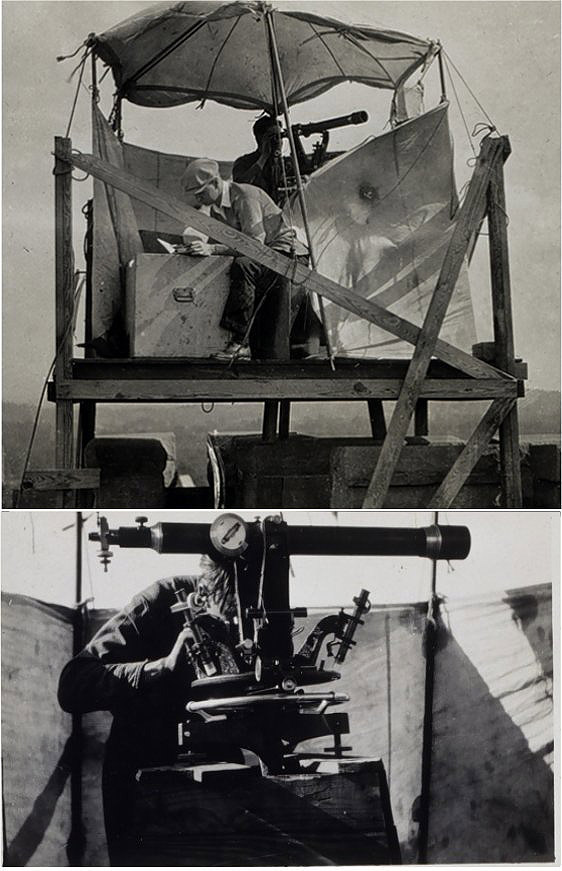 Thomas Jefferson's Theodolite
Thomas Jefferson's Theodolite Hassler's Camp
Hassler's Camp The Great Theodolite
The Great Theodolite Würdemann Six-inch Theodolite
Würdemann Six-inch Theodolite Heliotrope
Heliotrope Micrometer Scale
Micrometer Scale Theodolite Mounted on Water Tank
Theodolite Mounted on Water Tank Seven-inch Repeating Theodolite
Seven-inch Repeating Theodolite C&GS Twelve-inch Theodolite
C&GS Twelve-inch Theodolite Wild T-4
Wild T-4 K&E Theodolite, Parkhurst Design
K&E Theodolite, Parkhurst Design Wild T-2
Wild T-2 Wild T-3
Wild T-3 Topcon GPT-3002LW Total Station
Topcon GPT-3002LW Total Station
C&GS Twelve-inch Theodolite
This double image shows a crew using a 12-inch theodolite and illustrates two important roles in the surveying process: the observer (looking through the theodolite) and the recorder (writing down the observer's angles). This type of theodolite was used from the late 1800s until around 1930.

This image shows a crew and 12-inch theodolite and protective tent set up at station ARMORY in New York, during the 1925 observing season. In the top portion of the image, the recorder enters the angles as the observer reads and calls them, mentally doing calculations as a quick error check on the observations. In the bottom part of the image, the observer reads one of the instrument's four micrometer microscopes.
The 12-inch theodolite being used in the photo was considered highly accurate, but slow to operate because of the number of microscopes that had to be read. In order to compensate for flaws in the construction of the circle itself, readings were taken at four evenly spaced positions on the circle and averaged.
Setting a theodolite over a survey mark involved more than just plunking the instrument down. First, a stable tripod had to be set up or a stand of wood or steel had to be built to the necessary height - sometimes more than 100 feet. Tents and umbrellas were necessary to protect the instrument (not the observers!) from sun and wind. Once attached to its stand, the theodolite was carefully plumbed over the center of the mark and leveled. One crewmember observed while the other recorded the angles as the observer called them out. For an interesting, and possibly surprising, view of the location of the crew at ARMORY, look at the front-right corner tower of the building shown here.
Historic Reference
The Coast Survey purchased theodolites and transits (which are much like theodolites, but read somewhat differently), from various well-known makers. Instruments bearing the names of Würdemann, Casella, Fauth, Gambey, and Gurley, among others, saw increasing service as projects expanded across the continent.
The purchase of equipment was an expensive problem. In the Coast and Geodetic Survey Annual Report of 1929, the Director wrote that the type of equipment used by the agency was often very specialized and only needed in limited quantities, making it difficult to develop, as well as extremely expensive when obtained from private firms. He noted that after a bid of $4,000 was received for one such apparatus, the instrument division constructed it themselves for a total cost of $449.98!
Fortunately, the Coast Survey has never lacked for skilled designers and builders. One such designer was Ernest G. Fischer, who in the mid-1890s designed a 12-inch, three-microscope theodolite that bears his name.
- Instrument Shown: 12-inch theodolite built by Coast Survey
- Location: New York
- Manufacture Date: Late 1800s or early 1900s
- Dates of Use: Late 1800s until around 1930
- Photo Date: 1925
Works Consulted
Bowie, W. (1928). The Triangulation of the United States. Copy located of part 1 of a two part journal article filed at National Geodetic Survey. Journal unknown.
U.S. Coast and Geodetic Survey. (1929). Annual Report of the Director, United States Coast and Geodetic Survey, to the Secretary of Commerce for Fiscal Year Ended June 30, 1929. [Electronic version]. p 15.
